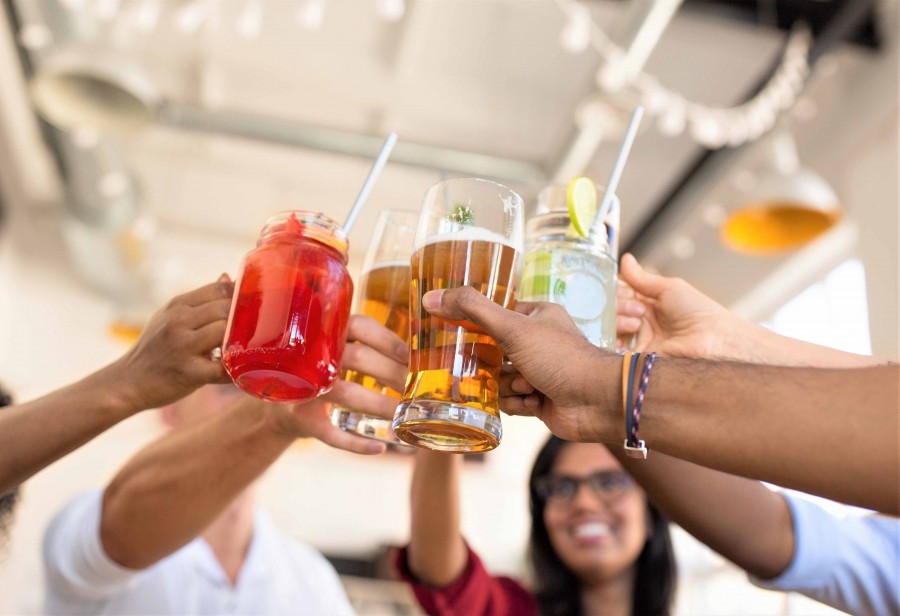Alcohol and diabetes: limiting the risks

Regardless of the type of diabetes you have, drinking alcohol in moderation is still possible. Guidelines recommend that no more than 14 units of alcohol should be consumed per week, for women and for men, and this consumption should be spread over a minimum of three days. A unit of alcohol is considered to be the equivalent of a single shot of spirits. A 125ml glass of wine is 1.5 units and a small bottle of beer (330ml) is 1.7 units.
Alcohol consumption can pose the risk of hypoglycaemia
Although alcohol and diabetes are not incompatible, people with diabetes who use insulin or insulin-stimulating medication (sulfonamides and glinides) run an increased risk of hypoglycaemia when they have an alcoholic drink.
Studies show that drinking alcohol increases insulin sensitivity, thereby lowering blood glucose levels. This side effect can occur up to 24 hours after consumption depending on the amount and type of drink; this is called delayed hypoglycaemia.
Which alcoholic drinks can limit the risks?
In order to minimise the impact on blood glucose, a person with diabetes should consider avoiding alcohol that is too high in carbohydrates. When going out to a pub or attending events, it is preferable to order a drink with no added sugar.
Studies also show that beer causes much higher blood glucose levels than, for example, wine or gin. Therefore, to limit the risks, it is recommended to order a glass of wine with a meal rather than a pint of beer.
Glycaemic index of alcoholic drinks
The glycaemic index (GI) is the ability of food or drink to increase blood glucose levels. Each type of alcohol has its own unique value.
Beer, with a GI of 89, and cane syrup, with a GI value of 78, are among the alcohol categories with the highest glycaemic power. Following those are soft drinks which are a key ingredient in many cocktails. They include in particular: energy drinks (GI 70), followed by fruit juices (GI 66) and fizzy drinks such as lemonade (GI 59) and cola (GI 58).
Wines and spirits belong to the alcohol categories with the lowest glycaemic index (GI 0).
Tips for reconciling alcohol and diabetes
If you do not have any other medical complications, the advice for drinking alcohol remains the same as for people without diabetes. You simply need to ensure frequent monitoring of your blood glucose.
In addition, when possible, it is best to drink alcohol with a meal. If consumed on an empty stomach, alcohol can promote hypoglycaemic events.
Lastly, try to favour alcoholic drinks with the lowest glycaemic index, such as wine. And remember, no matter what your situation, always drink alcohol in moderation.
Sources
- Richardson T, Weiss M, Thomas P, Kerr D. Day after the night before: influence of evening alcohol on risk of hypoglycemia in patients with type 1 diabetes. Diabetes Care. 2005;28(7):1801-1802.
- Emanuele NV, Swade TF, Emanuele MA. Consequences of alcohol use in diabetics. Alcohol Health Res World. 1998;22(3):211-9.
- Ley SH, Hamdy O, Mohan V, Hu FB. Prevention and management of type 2 diabetes: dietary components and nutritional strategies. Lancet. 2014 Jun 7;383(9933):1999-2007.
- Sluik D, Atkinson FS, Brand-Miller JC, Fogelholm M, Raben A, Feskens EJ. Contributors to dietary glycaemic index and glycaemic load in the Netherlands: the role of beer. Br J Nutr. 2016 Apr 14;115(7):1218-25.
- Volaco A. and Ercolano C.R. Alcohol Consumption and its Relationship to Diabetes Mellitus: Friend or Foe? Endocrinol Metab Int J 2018, 6(1): 00150.
- Engler PA, Ramsey SE, Smith RJ. Alcohol use of diabetes patients: the need for assessment and intervention. Acta Diabetol. 2013 Apr;50(2):93-9.


